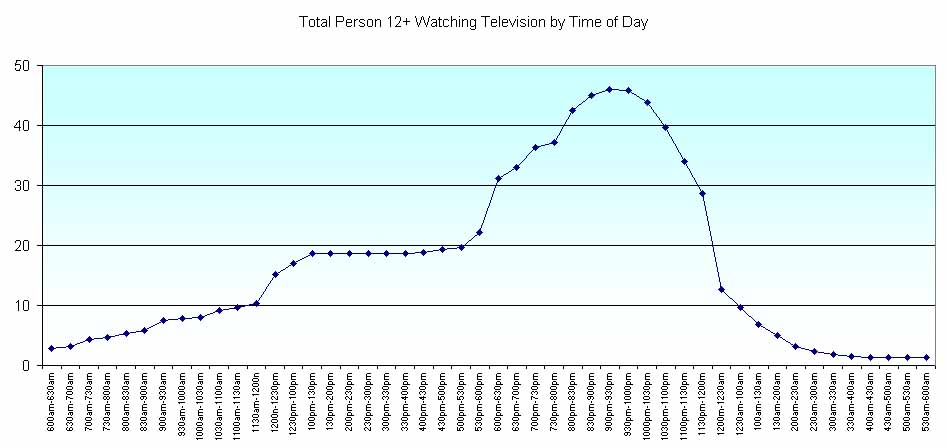
(source: 2004 TGI Brasil)
Television-Internet Usage by Time-of-Day
In a previous note titled The Impact of the Internet on Television Viewing, the claim was made that survey data showed no relationship between Internet usage level and television viewing level. That previous data had come the 1998 study Los Medios y Mercados de Latinoamérica when the Internet was still at its nascent stage. Have things changed today?
We will now refer to the 2004 TGI Brasil study. Within this study, the respondents are required to keep a time diary that recounted their activities over a full day. The information is recorded at the half-hour level about their activities: were they watching television? were they using the Internet? were they at the office? were they sleeping at home? and so on.
For the 13,312 survey respondents, it was found that they spent an average of 4.1 hours watching television each day. If the television viewing is broken out by the half-hour, the following distribution obtains. This is a familiar curve that peaks around what is known as the golden prime-time period of the day in the evening. This is nothing new, and the whole television industry is contructed around providing programs targeted towards the different numbers and types of audience members available during the day.

(source: 2004 TGI Brasil)
We are interested in how the Internet has affected television viewing. How can we address the question? It is easy if we just apply a filter to the population, identify the sub-population that claimed to have used the Internet in the last 7 days (or last 30 days) and produce the time-of-day curve. But what would that mean? Someone has just told us that got on the Internet some time during the last 30 days, but we don't know for how long and we don't when they did it. This is not a precise analysis of the impact of the Internet on television viewing. Even if we can classify people according to the number of hours spent (e.g. heavy users who are on the Internet for at least 3 hours a day), we still don't know how the Internet has affected television usage. For example, how does this affect the evening television viewing of someone who spends eight hours a day on the computer at the office?
So we take a different approach. For a specific half-hour (such as 800pm-830pm), we look at the sub-population who said that they used the Internet during that time. Then we compute the percentage of these Internet users who also said that they were watching television. This is therefore a measure of dual media usage, which we assert in our previous note was quite likely. The results from the TGI Brasil study are shown in the next chart below.

(source: 2004 TGI Brasil)
If this chart is peculiar at first, then it should become logically obvious after a few seconds of contemplation. When the two time series are compared, there are two obvious patterns of divergences. For some reason, the Internet users watch more television during the early morning hours and less during the day. Why?
In the wee hours of the morning, the solitary Internet user is more likely to keep the television on in the background as a companion. During that same time, the non-Internet user is more likely to be sound asleep with the television set off. This is how the ratings become higher among the Internet users during the wee hours of the early morning.
During the work day, the Internet user is likely to be an office worker who does not have the luxury of watching television. Meanwhile, housewifes and retirees keep their television sets on, and they do not fit the profile of Internet users. This is how the ratings become lower among the Internet users during the work day.
(posted by Roland Soong, 3/19/2005)
(Return to Zona Latina's Home Page)